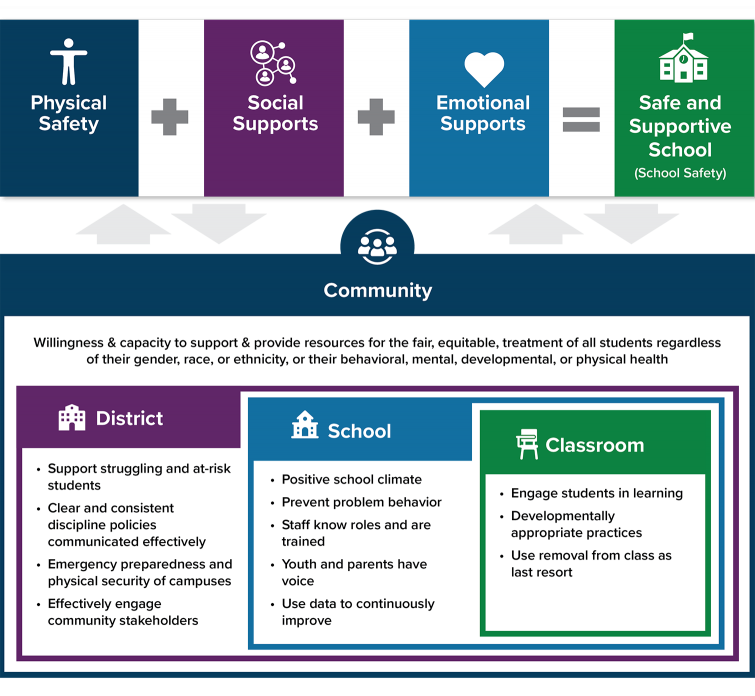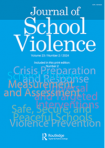Research on Lowering Violence in Communities and Schools (ReSOLV)

Background
In 2001, the first Surgeon General’s report on youth violence presented a comprehensive review of the root causes of violence and called for investment in cross-level research designs that examine multiple risk factors across individual, school, and community levels simultaneously. Since then we have learned that exposure to violence and adverse circumstances in multiple settings over time, can alter a youth’s developmental pathway and effects may linger into adulthood.
A comprehensive approach to school safety requires a focus on the root causes within the school and larger community setting. Schools and school staff must be prepared to apply comprehensive solutions that engage and build a strong collective bond with students, parents, and community partners, and also know how their own interactions with and among students influence school safety and educational outcomes.
The longitudinal Research on Lowering Violence in Communities and Schools (ReSOLV) study (read about the history of ReSOLV here) examined the association of school safety and student outcomes with school-based risk and protective factors and readiness to adopt a comprehensive school safety approach.
Study Hypothesis and Results
The researchers hypothesized that schools operate within a broader ecological framework and risk factors in the community can negatively affect student and school outcomes if schools are not actively working to recognize and mitigate these influences.
Want to get involved? Check out our resources to learn how, by sector:
Results from data collected between 2014 and 2022 confirmed this hypothesis. Within school attendance boundaries, the study found that crime and concentrated disadvantage, a collection of census-defined measures of poverty, single parent head of household, and other measures, had a negative influence on student and school-level outcomes, including higher chronic absentee rates, lower graduation rates, higher suspension rates, and lower percentages of students scoring at or above the median on standardized test results for English Language Arts and Math. These results were strongly significant.
The study also found that these community risk factors explained school and student outcomes much better than did measures of the internal school climate, including feelings of safety, relationships, engagement, and learning supports. And, school climate was universally worse in schools surrounded by the greatest amount of community risk and need.

Study Implications
The results from ReSOLV make clear that while it is necessary to improve school climate, instructional quality, and provide students, staff, and parents with safe and supportive conditions within schools, it is not sufficient to simply “fix schools” in otherwise disadvantaged areas and expect to produce better safety and educational outcomes. In other words, to create safe and supportive learning environments within schools, equal attention must be paid to create safe and supportive living environments using equitable strategies that engage a broader set of stakeholders.
To this end, ReSOLV has developed an alternative response model for organizing school and community collective action. The model is forthcoming in the Journal of School Violence. The ReSOLV model aims to create more effective and equitable solutions that are specific to each community's unique context, while providing a unified approach that any community can use to organize, manage, and assess the way they are working to address school safety and violence prevention priorities. In theory, the model can be used by communities as an inclusive and proactive tool for democratizing decision-making and increasing equity when adopting safety and violence prevention practices.
Study Locations
The study was conducted in one urban, one suburban, and one rural California school district, and findings will inform research, policy, and practice by focusing on school safety in communities where crime and violence is greatest.
Study Goals
- To help schools understand how risk and need factors in the community influence student engagement and outcomes in school, while helping community leaders understand how violence prevention efforts in the community may benefit educational outcomes for youth, which in turn can prevent future violence.
- Provide insights on building the readiness for individuals, organizations, and the broader community to work together to address violence and safety issues using inclusive, equitable, and comprehensive strategies that are rooted in evidence of effectiveness.
ReSOLV in The Journal of School Violence

Principal Investigators Dr. Patricia Campie (AIR) and Dr. Anthony Peguero (ASU) collaborated with Dr. Maury Nation (Vanderbilt) to create, and serve as co-editors for, a Special Issue of The Journal of School Violence, released in February 2024. ‘Racial/Ethnic Equity and School Safety’ highlights new research that touches on family, schools, neighborhoods, and communities. Common to all these articles is an understanding of the challenges, barriers, consequences, and importance of connecting minoritized students to provide opportunities and protection. Thus, each of these articles takes care to identify points for intervention, suggestions for policy, and promising directions for future research.
The ReSOLV project contributed a paper to this special issue introducing its approach, a model generated from Elinor Ostrom’s Institutional Analysis Framework, as an alternative for adopting equitable and evidence-based strategies to reduce violence in schools and communities.
ReSOLV was done in partnership with Dr. Anthony Peguero, Professor of Criminology & Sociology at Arizona State University. His research interests involve youth violence and school safety. Dr. Peguero is a member of Latina/o/x Criminology and Racial Democracy, Crime, and Justice Network and which hold the goals of advancing research on the intersection of race, crime, equity, and justice.
ReSOLV Council of Advisors
Amy Azano
Virginia Tech, School of Education
Brian Bumbarger
Griffith University Institute of Criminology/
Penn State University Prevention Research Center
Ruth Cusick
The Collective for Liberatory Lawyering
Larry Fondation
United Parents and Students
Los Angeles
Denise Gottfredson
University of Maryland (Professor Emeritus)
Department of Criminology and Criminal Justice
Gene Hall
University of Nevada, Las Vegas
Educational Psychology and Higher Education
Vera Lopez
Arizona State University
School of Justice and Social Inquiry
JoJo Reyes
Mendota Representative
Mendota Unified School District
Victor Rosa
Hanford Representative
Hanford Joint Union High School District
Abe Wandersman
University of South Carolina Department of Psychology/
The Wandersman Center
Project History
The National Institute of Justice created the Comprehensive School Safety Initiative (CSSI) to improve knowledge about the root causes of school violence, develop strategies to increase school safety, and rigorously evaluate innovative school safety strategies. In support of the CSSI, AIR—in partnership with Arizona State University, The Wandersman Center, Dawn Chorus Group, and a group of nationally recognized school safety experts—is conducting Research on Lowering Violence in Communities and Schools (ReSOLV), formerly known as the California School Safety Project. This longitudinal study examines the association of school safety and student outcomes with school-based risk and protective factors and readiness to adopt a comprehensive school safety approach.
ReSOLV in The Journal of School Violence
Learn more about the Special Issue of The Journal of School Violence, released in February 2024. ‘Racial/Ethnic Equity and School Safety’ highlights new research that touches on family, schools, neighborhoods, and communities. The ReSOLV project contributed a paper to this special issue introducing its approach.
